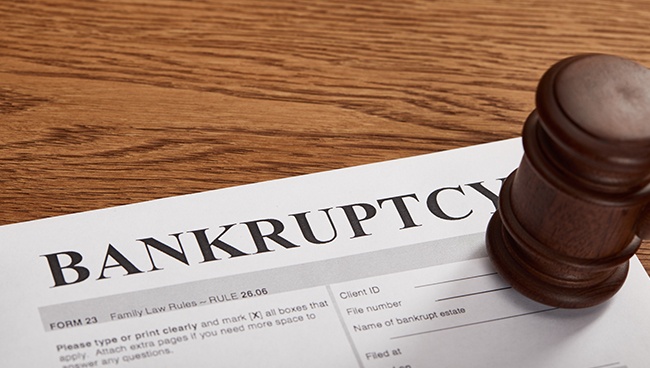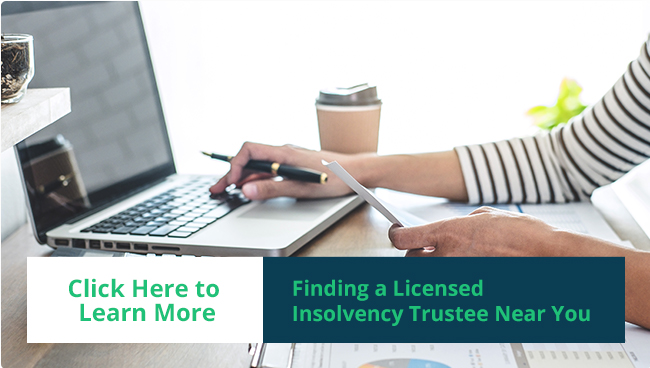On This Page
Do you have a mountain of debt and nowhere to turn? If this is the case, filing for bankruptcy in Canada maybe your best option; however, you must examine several factors before taking this move. Here are five facts regarding bankruptcy in Canada that can help you decide if it's the correct thing to do. It is important to note that when we discuss filing for bankruptcy in Canada, we are referring to a Consumer Proposal or Bankruptcy, which would necessitate the help of a Licensed Insolvency Trustee.
If you're thinking about declaring bankruptcy in Canada, here are five things you should know before you begin.
What Is the Distinction Between a Bankruptcy Attorney and a Licensed Insolvency Trustee?
A bankruptcy lawyer is known as a Licensed Insolvency Trustee in Canada. The terms “bankruptcy lawyer,” “bankruptcy trustee,” and “Licensed Insolvency Trustee” are commonly used interchangeably – but in Canada, the official term is a Licensed Insolvency Trustee (LIT). A LIT can assist you in becoming more organised by asking questions such as how much debt you have and how long it will take to repay it. An LIT can also assist you in gathering papers such as loan agreements and tax returns so that he or she can determine which assets can be converted into cash and which creditors must be paid off first. Once you've gathered all of these facts, your qualified insolvency trustee will assist you in creating a proposal (or plan) that describes all of your obligations, assets, income sources, and spending. If a debtor files on his or her own without consulting a licenced insolvency trustee, he or she runs the danger of making mistakes when filling out papers and gathering relevant information for financial computations. A bankruptcy lawyer (also known as a Licensed Insolvency Trustee in Canada) handles these time-consuming tasks, allowing you to focus on your emotional health and improving your financial condition.

Why Do People File for Bankruptcy?
In Canada, the most common reason for declaring bankruptcy is that the individual has become insolvent. The first thing you should learn about bankruptcy in Canada is what it means to be insolvent. Being deemed insolvent might be rather subjective; but, in general, you are considered insolvent if your debts exceed the amount payable on all of your assets. The truth is that becoming bankrupt is extremely prevalent in Canada. According to ValueInsured data, one in every six Canadian households is one severe sickness away from financial ruin, and 40% of Canadians live paycheque to paycheque. Essentially, if you find yourself in a bad financial circumstance, you are not alone. While going insolvent may appear to be a frightening prospect at first, it may simply signal that now is the time to make some changes and safeguard your money for years to come. If you are considering filing for bankruptcy in Canada, you should first contact a Licensed Insolvency Trustee. Most LITs provide a free consultation, allowing you to acquire the information and support you require without having to pay anything up front.
Who is Eligible to File for Bankruptcy?
In Canada, almost anyone can declare bankruptcy, but it's not something you should do without careful consideration. Bankruptcy filings are generally permitted only if you are a person or a business with overwhelming debt. This is because courts do not look kindly on persons who seek bankruptcy to avoid paying their debts. Small firms are the most likely to declare bankruptcy (newspapers tend to cover these stories). As a result, keep in mind that we're discussing personal or corporate bankruptcy here, not commercial bankruptcies such as those filed by General Motors Co., Valassis Communications Inc., Circuit City Stores Inc., Sharper Image Corp., and others. These are large corporate bankruptcies with enormous capital losses. These are severe issues that go beyond the scope of your simple advice on how to file for bankruptcy in Canada.
What are your alternatives to declaring bankruptcy?
The best alternative to declaring bankruptcy is to avoid it entirely. This entails spending less than you earn, paying down debt on a regular basis, and developing a savings strategy. The majority of people declare bankruptcy because they simply cannot afford to pay their bills or meet their financial responsibilities. But what about individuals who may be able to repay some or all of their debt over time? If you fall into this group, a consumer proposal is the best alternative to filing for bankruptcy. A consumer proposal will help you to restructure your debts while providing you time to get back on your feet within the protection of the law. It also allows you to keep your assets, such as your family house and automobile while remaining self-employed. When creditors approve a consumer proposal, your personal accountability ends—but remember, it's critical to follow the conditions of the plan.
A consumer proposal is similar to bankruptcy in that it would also wipe off your debts if you follow a court-approved plan. However, unlike bankruptcy, you can keep certain assets and continue to work for yourself. You'll need to hire an accredited bankruptcy trustee to help you establish a plan. These practitioners are known as Licensed Insolvency Trustees in Canada (LITs).
Consolidation of Debt
Debt consolidation is the process of paying off all of your debts with a single lump sum. For example, if you have $10,000 in credit card debt but only $2,000 in savings, you have an additional $8,000 in debt (the difference between what you owe and what you have saved). It should be able to pay off all of your credit cards and be free of any long-term monthly obligations by taking out a debt consolidation loan or borrowing money from a friend or family member on top of your savings deposit. In other words, debt consolidation aids in the conversion of short-term liabilities into long-term assets, at least in terms of personal finance management. One thing to bear in mind is that by consolidating your debt and making one larger payment toward the repayment of numerous smaller ones, you will also be eliminating any interest rates you were previously paying. This is because every dollar is put to principal rather than recalculating compound interest each month.
The proposal from a Consumer
A consumer proposal is a formal offer made by you, the consumer, to your creditors (people you owe money). Only a licenced insolvency trustee can file one on your behalf because it is governed by provincial and federal governments. When you are an individual, the process is known as filing bankruptcy, but filing a consumer proposal is sometimes referred to as establishing a voluntary agreement with creditors. Those who file for personal bankruptcy in Canada are referred to as debtors, whereas those who have filed or will file a consumer proposal are referred to as debtors. Personal bankruptcies and proposals both include dealing with all of your unsecured obligations, which do not include mortgages, government loans, or property-secured lines of credit.
A consumer proposal can be used to forgive a considerable percentage of the debt and combine it. Because you don't have to make as many payments to your creditors, a consumer proposal may be preferable to bankruptcy. Instead, you make a single monthly payment until your debts are paid off.
Where Can I Find a Licensed Insolvency Trustee?
To file for bankruptcy in Canada, you must work with a Licensed Insolvency Trustee (LIT). LITs assist consumers in complying with legal requirements by managing and settling bankruptcies through required procedures. While you may discover a list of licenced insolvency trustees online, it's always a good idea to double-check their credentials before making a commitment. When contemplating bankruptcy possibilities, it is critical to maintaining a clear separation between personal relationships and financial decisions; utilising an unbiased third party is always recommended.
Searching “licenced insolvency trustee” online and finding a reputed trustee near you is a wonderful approach to find a suitable Licensed Insolvency Trustee. To obtain a feel of how capable and helpful the trustee is, browse through reviews and the company's comments to those reviews. Then contact them and inquire if they provide a free consultation. Most Licensed Insolvency Trustees, such as Remolino And Associates, provide a free consultation to assist you in getting started.
Another option is to go to the government of Canada's official website, which includes all licenced insolvency trustees. You may then select an area and filter your results to see which trustees are accepting new clients. LITs that operate beyond provincial boundaries will be mentioned individually so that you may easily discover one near you no matter where you live.
The website of the Government of Canada also has a lot of valuable information on filing for bankruptcy or a consumer proposal. You may also find out what it takes to become a licenced insolvency trustee in Canada, as well as what to look for in a trustee.
Brought to You By:
Remolino And Associates
1180 Danforth Ave, Toronto, ON M4J 1M3
(416) 792-5599
The Article 5 Things You Need to Know Before Filing for Bankruptcy in Canada was found on https://limitsofstrategy.com
The post 5 Things You Need to Know Before Filing for Bankruptcy in Canada appeared first on https://gqcentral.co.uk




